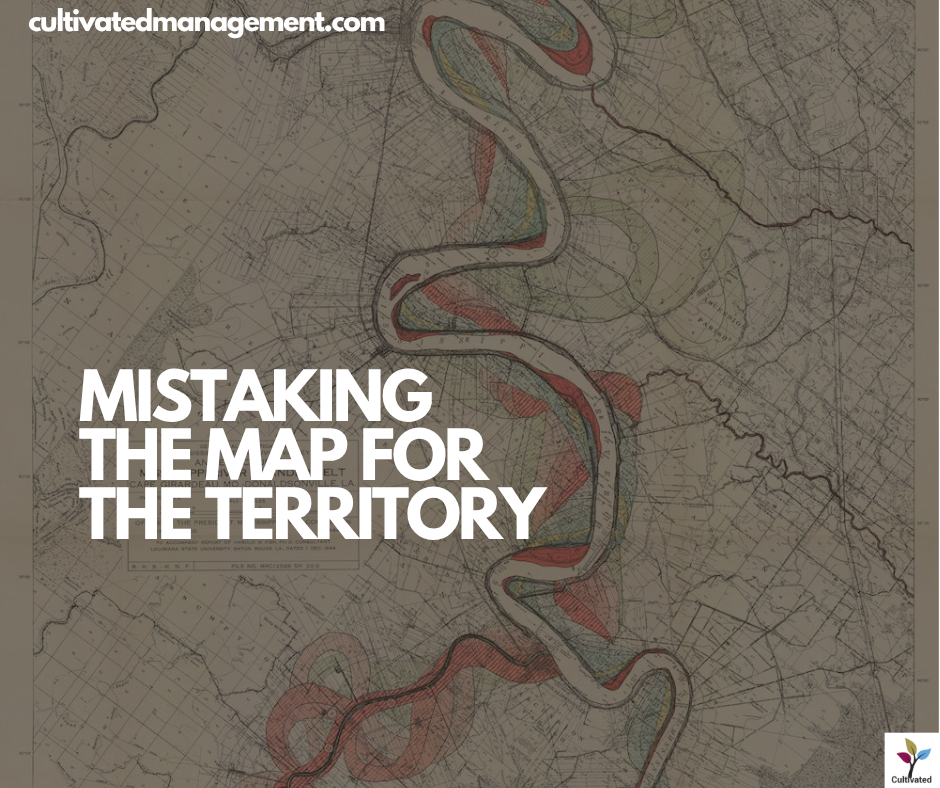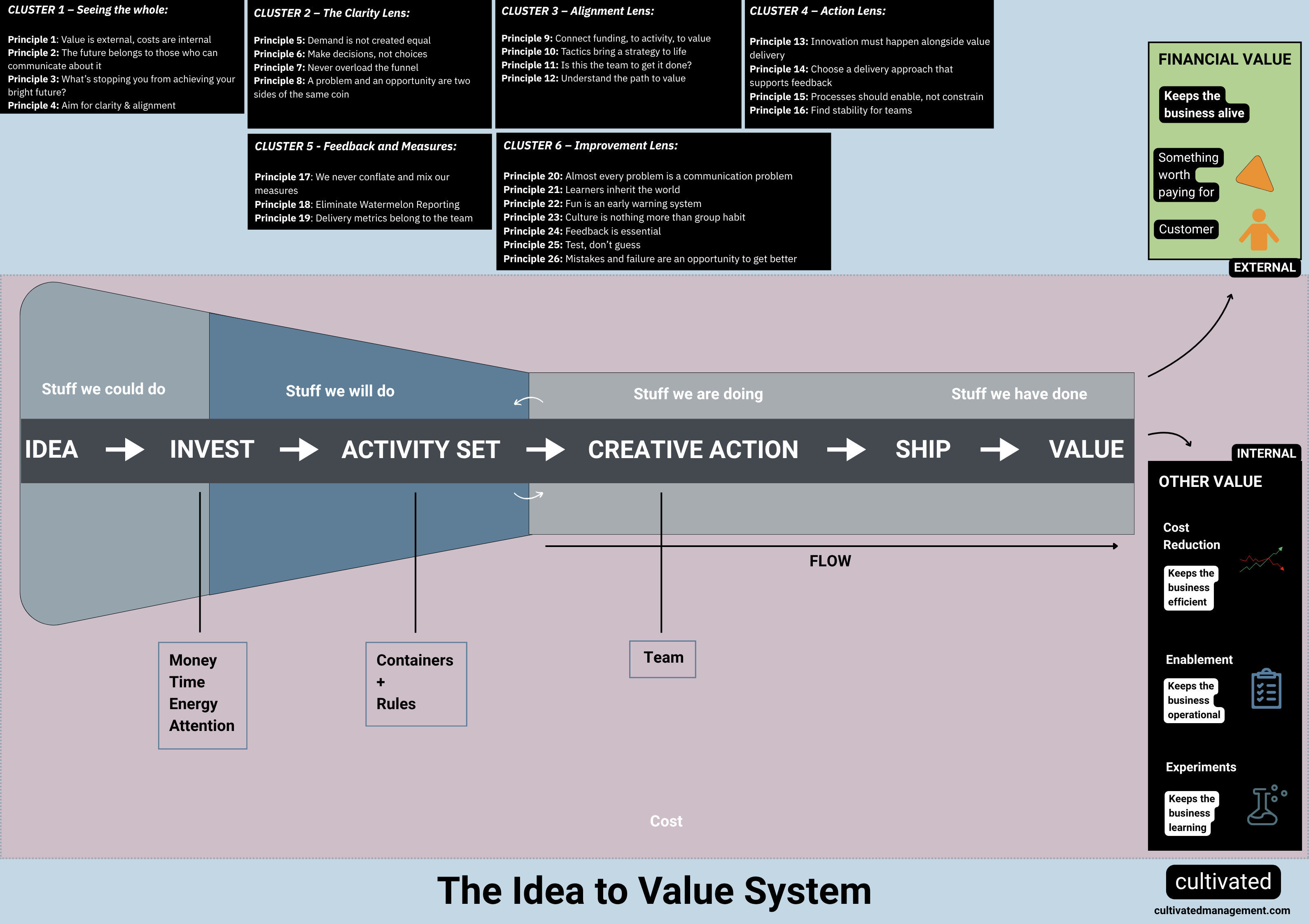
Hey,
I hope you are doing safe and well, and life is good for you. I've been super busy these last two weeks, with a couple of mini workshops and a few consulting calls, plus plenty of video creation.
I've also been working out how my ecosystem hangs together and what each of the mediums does - and how they all support each other. More on that soon.
I do have a new, revised, and minimalist version of "Forget Time Management: Energy and Attention is Where It's At" coming soon. I am also about four chapters into writing the Squirrels Who Ruined Everything book. Both joyful to create.
For those new to the Meeting Notes newsletter, welcome, I’m Rob, Chief Value Officer at Cultivated Management. This newsletter is about mastering the art of communication and creativity - and cultivating a bright future of work.
Spreadsheets Don’t Tell the Truth
The economic premise beneath the Idea → Value system is simple:
we only generate financial value (revenue) when we create something worth paying for — and someone is willing to pay for it.
Everything else inside a business is cost.
Many people, even senior leaders, don’t really grasp this.
The goal isn’t to cut costs initially; it’s to move from idea to external value as smoothly and quickly as possible — keeping the intelligence and quality that make the product or service worth buying. In other words, get effective first at going from idea to external financial value, and then work out how to be efficient (ideally without consulting a spreadsheet of salaries).

A few years ago, I worked with a company that forgot this, or didn't understand it.
Their UK team had built a brilliant product. It met needs, had quality, had intelligence, and contained the kind of small decisions and insights that separated it from competitors. Customers paid for it gladly. It was something worth paying for.
But the department was taken over by accountants (or people who saw the world like accountants). They saw the business through financial spreadsheets — and spreadsheets only show cost. Each line item with a salary beside it was, to them, just an expense to be reduced.
They launched a cost-cutting programme. On paper it looked logical: fewer senior staff, more juniors, a blend of nearshore and offshore delivery.
The spreadsheet told them they’d saved money.
Reality told a very different story.
Quality slipped. Reliability dipped. Intelligence in the product diminished. Customers called support (cost). Costs quietly reappeared elsewhere. New business slowed as reputation faded.
This part of the business was tanking.
Within six months they were hiring back 50 % of the original team — now as contractors, at twice the rate — to fix the mess. Which, yes, increased costs.
I joined them at that point and sat with the executive team. The diagnosis was obvious, even if they didn't want to hear it from a middle-aged man from Yorkshire:
- They’d reduced salary costs but increased total costs (remember, everything inside the business is cost).
- They’d managed by spreadsheet instead of purpose.
- And they’d lost the thing that produced revenue in the first place — something worth paying for and customers to pay for it.
We rebuilt the team, refocused on effectiveness first, then looked for true efficiency. Within three months the product was stable again, customers were returning, and the business was breathing normally. This was not possible without help from marketing and client management, who, with a more stable product, were able to convince customers to come back and new customers to join.
You see, we always need something worth paying for to generate financial value. Everything involved in the delivery of this, plus everything else in the business is cost.
But to focus on cost reduction of salaries is to miss how people come together in the messy middle to deliver something worth paying for.
Spreadsheets don’t show how people communicate, how people solve problems, how people use their strengths. Spreadsheets don’t tell you about the spirit, hope, mood, drive, and emotion of the teams.
Spreadsheets don’t tell you how people add more intelligence, quality and customer centricity into a product, so that it becomes something worth paying for. Spreadsheets tell you nothing about culture.
Between an idea and financial value lies the messy middle — a mix of complicated process, and people.
The first can be mapped and measured and, with willing, improved.
The second must be cultivated.
People are the engine of success. They’re also the biggest cost on a balance sheet — but without them, there is no balance.
To look at the business through the lens of process and a cost spreadsheets is to miss the fundamental reality of going from idea to value.
In the middle is essentially communication; goals, routines, meetings, people, relationships, collaboration, cooperation, coordination, community, culture, behaviours, decisions, discussions, debates, ideation, creativity, innovation, improvement - all elements of communication. (which is why I say 99% of problems are communication problems). All areas that can either support in moving from idea to value, or cause delays, confusion and cost.
The Idea → Value system is designed to handle both sides:
- the complicated process of moving ideas through a business
- and the complex reality of people creating together
To manage by cost alone is to mistake the map for the territory.
Spreadsheets are useful.
But they don’t tell the truth about what really creates value.
Quote of the Week
“The single biggest problem in communication is the illusion that it has taken place.” — George Bernard Shaw
🚀 Creative Soul Projects
Alongside my work at Cultivated Management, I take on small creative projects that keep me experimenting and learning.
This week has been a new video on using walks as creative fodder - as a way to generate ideas. I'm very pleased with this video - still learning how to use music to elevate the experience, but spent way longer than I should have on this one:
Support Cultivated Management
This newsletter is a labour of love and will always be free, but it's not free to create it - if you’d like to support my work:
🚀 Buy a book, or sit a course.
🏢 Work with me
🎧 Listen to the podcast
👉 Connect on LinkedIn : https://www.linkedin.com/in/robertlambert/
📸 Daily videos on Instagram: https://instagram.com/cultivatedlabs
📸 Check out YouTube: https://www.youtube.com/@creativesoulprojects
Until next week.
Take care of yourself and others.
Rob..

